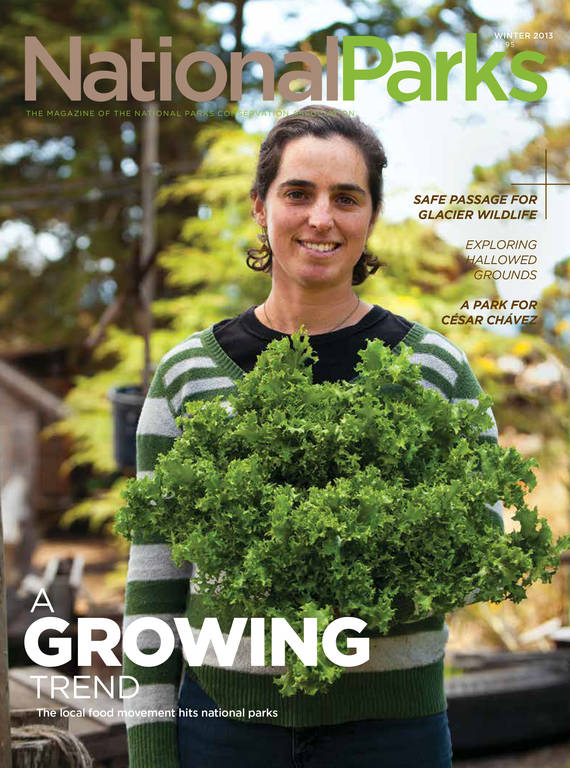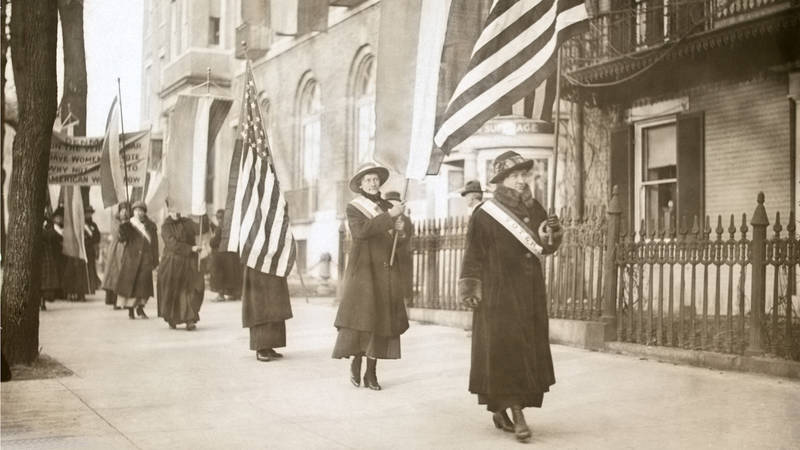Winter 2013
The Anniversary Gift
As Civil War sites continue to mark 150 years since America’s most important conflict, Harpers Ferry, Antietam, and Gettysburg tell old stories in a new light.
Before daybreak one summer morning, I leave Washington, D.C., and head northwest, more or less parallel to the Potomac River, until it meets the Shenandoah River in Harpers Ferry. I park my car and soon find myself walking along a quiet sidewalk in the 19th century. It is early still, and the park rangers are just beginning their shifts. I walk by a building with a Fancy Goods sign, which now houses the park bookstore. The historic blacksmith and dry goods buildings open to reveal museum exhibits. And the first person I pass on the street, on this already scorching day, is a woman dressed in period clothing.
Although I live within an hour’s drive from a handful of Civil War battlefields, the last time I visited one, I was young enough to need a chaperone. So I decided, in honor of the Civil War’s 150th anniversary, it was time to take a field trip. My plan was to visit three national parks in two days and take on Civil War history as a grown-up, rather than as a social studies student. My first adult thoughts on visiting Harpers Ferry: I wanted to know what life was like for the baker and the blacksmith as the country headed into America’s costliest and bloodiest war.
A Town, a Story, a Hiking Hound
TRAVEL ESSENTIALS
I walk into the John Brown Museum to meet David Fox, a national park ranger. We’re now about halfway through the war’s sesquicentennial, but one of the first things he tells me is that we’re still having some of the same discussions today as our forebears did 150 years ago. “My job is to interpret and make things relevant today,” Fox says, as we walk out of his office and back onto the quiet street. “We’re really repeating history. When does terrorism become freedom fighting?” Big questions like that—and what it means to be an American—have kept Fox here for 23 years, endlessly inspired by the past.
We walk to the point where the Potomac and Shenandoah Rivers converge and the Appalachian National Scenic Trail cuts through town. Fox points out the gap in the Blue Ridge Mountains that has given people access to this spot for thousands of years. The natural beauty is striking, and it’s clear to me why this town is so seductive to hikers, rafters, and kayakers. It is equally clear—seeing the powerful moving water—how this spot once became a bustling industrial center.
The park extends to three states, which meet about a mile down river from where we stand. But it’s simply too precarious for a visitor to stand in all three at once. “You’d have to have one foot in the river in Maryland and one foot straddling the Virginia-West Virginia boundary on the shore,” Fox says with a laugh. “It’s a very rocky and steep bank, and you’d probably get poison ivy.”
As we walk past the historic buildings, Fox talks about a U.S. president trying to increase his defense budget to promote democracy. Not a modern president, mind you; he is referring to George Washington—who more than two centuries ago wanted an armory here so American soldiers could defend our growing country. In time, weapons manufacturing became the town’s big business, with the armory churning out more than 10,000 rifles and muskets a year. It also played a hand in the future of our nation. “Without an armory,” Fox explains, “there are no weapons for the Lewis and Clark expedition, no John Brown raid, and no start of the Civil War.”
In 1859, John Brown attempted to seize the stored weapons as part of his scheme to abolish slavery. Fox and I walk into the fire-engine house, the only existing armory structure. He becomes animated, recounting in theatrical detail the scene in this very building when Brown was captured by U.S. marines led by Lt. Robert E. Lee. “There were more than 2,000 spectators,” he says, “some yelling, ‘Lynch him!’ He was almost 60 years old, he’d been here 36 hours with no food.…” Then he stops abruptly. “Oh, I’m falling into the John Brown trap,” he says, smiling. “It happens to all the rangers.”
Brown’s trial and execution that same year forced the nation to look at the issue of slavery, and set a spark that would ignite the war. Harpers Ferry, trapped on the border between North and South, changed hands eight times during the war.
I mention to Fox that I plan to walk to lunch in the neighboring town, and he points me in the right direction. I walk up a steep hill, outside the park borders, and discover a side of Harpers Ferry that brings me back to the 21st century—a tavern, souvenir shops, houses with porch swings and ornamental animals. En route to the town of Bolivar, I stop at the Appalachian Trail Visitor Center, where I run into a few folks who are hiking the entire stretch from Georgia to Maine. The distinctive odor of a perpetual camper drifts behind them. I meet Polly, a miniature dachshund wearing a pink bow, who has been hiking with her owner for three months. They have stocked up on camping cookware and are ready to hit the trail again. And I’m pretty hungry for lunch at this point, so I continue walking, preoccupied with the exhausting thought of hiking through entire states.
Cornfields and Ice Cream Cones
After lunch, I head to Antietam National Battlefield in Sharpsburg, Maryland. As I approach the visitor center, I am overwhelmed by the beauty of the cornfields and the landscape, remarkably unchanged in the past century and a half. If Harpers Ferry is wild and unpredictable, with its floods, hard edges, and whitewater, then Antietam’s gift is a backdrop of quiet rolling hills, eerily calming and peaceful. The Antietam battlefield covers more than 3,200 acres of farmland, pastures, and forests, and it looks very much as it did in 1862, down to the zig-zag wooden fences. But these beautiful stretches of land are best known for their role in hosting the bloodiest single-day battle in American history. On September 17, 1862, a battle began in the Miller cornfield north of town. Twelve hours later, 23,110 soldiers were dead, wounded, or missing. To put that in perspective, the Iraq war has seen about 37,000 casualties (dead and wounded) in nearly 10 years.
I catch a ranger talk in the visitor center observation room, which looks out to a rolling sea of green fields and woods. There is something incongruous about absorbing this serene panorama while listening to the story of this land—a story of men standing shoulder to shoulder, killing each other. The visitor center includes a small museum, but I find it easier to soak up the story on the self-guided driving tour. I am struck by the expanse of the fields and how quickly the battles swallowed entire communities, from farmhouses to churches.
The tour crosses a couple of main thoroughfares, and near the end, I take a detour into town for a scoop of ice cream at Nutter’s, where the line snakes nearly out the door. Walls and shelves are covered with decades-old knickknacks (including a large collection of ceramic cows) and photos of local Little League teams. Nearby Battlefield Market, on the other hand, isn’t quite so charming, but you have to appreciate a retailer that can stock Civil War action figures next to fish hooks and bait and offer sandwich specials called the Robert E. Lee and the Lincoln.
That night, I sit in on the weekly bluegrass jam at O’Hurley’s General Store in Shepherdstown, a town that essentially served as a sprawling field hospital after the Battle of Antietam. For an hour after the jam begins, musicians trickle in, unfolding chairs and sitting down with some bygone-era instruments like the mountain dulcimer (a relative of the zither that looks like an elongated fiddle). The old Appalachian and Irish tunes range from uplifting to haunting, and the musicians eventually outnumber those of us in the audience. It is a joy to watch them circle around, selecting songs and delighting in their music-making. I get the feeling that they would be having just as much fun had none of us shown up to listen.
Gettysburg by Foot, Wheel or Hoof
I spend the night in Harpers Ferry and awake the next morning to the sound of a train passing through one of the few working train stations in a national park. After a short hike on the Appalachian Trail (and a pause to take in the spectacular view from Jefferson Rock), I hit the road and continue hopscotching between states, passing sweet corn and peach stands along Rte. 15.
My first stop in Gettysburg is the town hall. I find Mayor Bill Troxell sitting behind a desk adorned with a jar of Tootsie Rolls and a jar of no. 2 pencils. Troxell’s great-great-great-grandfather is known as Gettysburg’s first settler, and his great-grandfather owned a carriage factory that was damaged during the Civil War. I’ve heard Troxell is one of about 150 licensed battlefield guides here, so I ask if he’d show me around. We head out in his Chrysler sedan, passing businesses like Union Cigar Club and Hunt’s Battlefield Fries and Café. “Every night we take our toy poodle for a drive through the battlefield,” Troxell tells me. He was 11 years old at the battle’s 75th anniversary in 1938 and fully expects to be around for the 150th this summer.
We enter the park, which surrounds the town, and make several stops at monuments and markers. The three-day battle in early July—nine and a half months after Antietam—was a turning point in the war, ending the Confederacy’s invasion of the North. The lively town of 2,400—Gettysburg had three newspapers at the time—was left to nurse thousands of wounded. The recovery effort for Gettysburg was staggering: When the armies left town, the dead and wounded outnumbered the living 11 to one. The Confederate retreat included a wagon train full of wounded men, which stretched 17 miles. No matter where we stop, there are other tour groups nearby—Segway tours, bus tours, horse tours. Compared with my previous two park visits, Gettysburg is bustling.
After my tour, I stop by the restored train station where President Lincoln arrived the night before his Gettysburg Address. (Read about efforts to add the site to the park on page 12.) Then I continue to the Gettysburg National Military Park Museum and Visitor Center, a gorgeous building that opened in 2008. The famous 1884 cyclorama painting of the battle (which I’d seen in the ‘80s) recently underwent a multi-million-dollar restoration, and today, it’s extraordinary. Standing on an observation platform, visitors have a 360-degree view of the painting—which becomes three-dimensional, thanks to dioramas dotted with boulders, bushes, and artillery reaching out from the base of the canvas. There is a short presentation with dramatic lighting and audio that is so powerful, the painting comes alive like a Ken Burns film. Engulfed by the sights and sounds of battle all around me, I have a glimpse of the devastation that comes with war. Out of everything I’ve seen over two days, this giant display of oil paint and canvas provides one of the best and most concise insights yet into the character of a Civil War battle.

National Parks
You can read this and other stories about history, nature, culture, art, conservation, travel, science and more in National Parks magazine. Your tax-deductible membership donation of $25 or more entitles…
See more ›I quickly walk through the visitor center museum, where I pass grown men gripped by a display of love letters from the war. Outside, I sit under a tent with a group of a dozen visitors for a talk on Civil War medicine. The ranger explains that there was no concept of germs in the Civil War era, so doctors would innocently pack lint from the floor of a textile factory into a wound to stop the bleeding. We all cringe. But germs aside, medical advancement—like the ideas of triage and medical records—is considered a major legacy of this war. The ranger passes around old photos and medical tools to the group and shares one fascinating tidbit after another. From under the tent, I hear a few rumbles. The forecast is calling for rain but, still in a battlefield mindset, I’m not sure whether it’s thunder or a recording of cannon fire. In either case, it’s late in the day, so I walk toward the enormous parking area, passing tourists armed with cameras and water bottles.
On Rte. 15, I’m whisked back to the present. But I am surprised by how much of these three parks—our history, our land, our people—I’ve brought with me. Sitting next to a seat filled with brochures and maps, I find myself looking out the windshield through a slightly different lens. I pass a billboard advertising a gun show, followed by signs welcoming me to Maryland and announcing the Mason-Dixon Line. Soon, I’m following the Potomac home again—back to the city named for the president who wanted an armory built on the river. Perhaps at this point, a chaperone would say something succinct and clever to conclude the field trip. Alone, my thoughts are less tidy. But I can’t help agreeing with Fox from Harpers Ferry—scores of years later, many things haven’t changed. We remain a land seeking protection, a populace struggling for a certain way of life, and above all, a country endlessly debating the solutions.
About the author
-
 Melanie D.G. Kaplan Author
Melanie D.G. Kaplan AuthorMelanie D.G. Kaplan is a Washington, D.C.-based writer. She is working on a nonfiction book, "Science & the Hound," to be published in 2025.



